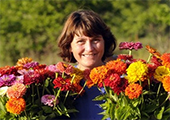- Succession-Planting Interval Chart for Herbs
- Growing Herbs in Containers | Tips for Production of Professional-Quality Container Herbs
- Herb Culture | Comparison Chart (PDF)
- Beyond Cilantro: Top 5 Culinary Herb Trends
- Mouthwatering Combinations: Culinary Herbs + Farm-Fresh Produce
- Destination Herb Farms: Hospitality Farming & Agritourism
- Growing Herb Plants for Direct-Market Sales
- Economic Outlook for Culinary Herbs
- Marketing Herb Plants | Building a Brand for Your Herb Business
- Overwintering Perennial Herbs
- Turning a Profit by Growing Herbs | The Useful Plants
by Lynn Byczynski, Author & Founder of Growing for Market
Herb plants are popular offerings at farmers' markets and retail garden centers. Most herbs can be started easily from seed and grown into marketable size in a few months. A few perennial herbs are more difficult or time-consuming to grow from seed or they are cultivars that won't come true from seed, so these are often grown from softwood cuttings. This article is an introduction to propagating culinary herbs for plant sales.
Growing Herb Plants from Seed
The most popular culinary herbs are also the easiest to grow from seed. Basil, chives, dill, marjoram, oregano, parsley, and sage can all be started in the greenhouse using the same methods used to start vegetable transplants. Herb buyers may be especially interested in organically grown herb plants, which require organic seed-starting and potting mixes as well as organic fertilizers. Organic seed is available for many herb varieties.
Herb seeds are usually started in a channel tray or open flat on a heat mat and then transplanted into the final pot or cell pack when they have two sets of true leaves. Many herb seeds require light for germination and should not be covered with soil or a dark cover, nor started in a dark germination chamber. Instead, the growing mix should be wetted first, then the seeds should be placed on top of the growing mix. A sprinkling of sand or vermiculite will help keep the seeds moist without burying them. A clear plastic dome or piece of row cover can be used to increase humidity, and if the flat does need to be watered, it should be either bottom-watered or misted, to prevent the seed from being displaced. Plastic domes should be removed as soon as the first seeds germinate, to keep from overheating the tiny seedlings.
Germination Requirements Chart for Herb Seeds
The chart below shows germination requirements for the top culinary herbs that are typically grown from seed.
| Germination requirements for seed-grown culinary herbs | |||
| Common name | Germination temperature | Cover seeds? | Days to germinate |
| Basil | 70°F/21°C | yes | 5–10 |
| Chives | 70°F/21°C |
yes | 7–14 |
| Dill | 60°F/15°C |
no | 10–21 |
| Marjoram | 70°F/21°C | no | 7–14 |
| Oregano | 60°F/15°C | no | 7–14 |
| Parsley | 70°F/21°C | yes | 21 |
| Sage | 70°F/21°C | yes | 7–21 |
| Thyme | 70°F/21°C | no | 14–21 |
Byczynski and her family have been growing vegetables and cut flowers since 1988, selling through CSAs, at farmers' markets, to chefs, grocery stores, and florists. They currently grow cut flowers and hoophouse tomatoes on about 2 acres of their 20-acre farm near Lawrence, Kansas.
She is also the author/editor of two of our favorite books about market farming, The Flower Farmer and The Hoophouse Handbook.



